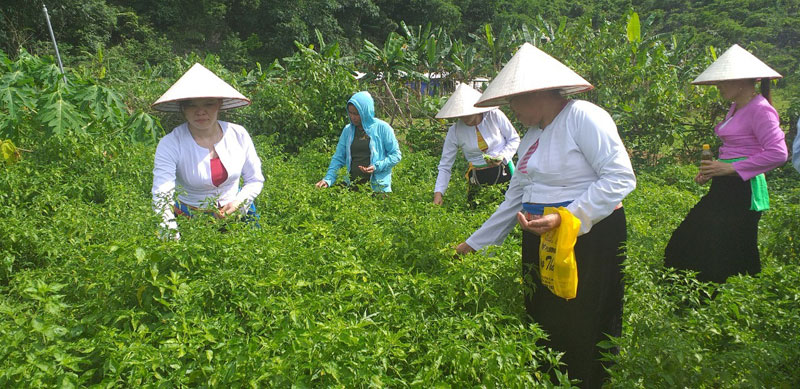
(HBO) - Forestry Chili has been a long time in Phu Luong. The people often go to the forest to collect chili to make the spice for everyday meals. Indeed, only the soil and climate conditions of Phu Luong region make forestry chili have a special aroma and a spicy taste. If they fertile in alluvial soil, the original characteristics will be lost.
 The members of Phu Luong forestry chili cooperative (Lac Son) are collecting chili.
The members of Phu Luong forestry chili cooperative (Lac Son) are collecting chili.
Having seen the value of wild chili, the people have been looking for the seeds to grow and sell in a small ways. Since the establishment of Phu Luong forestry chili cooperative in 2018, the women in Ban hamlet, Phu Luong commune have more opportunities to help each other in developing production, contributing to building the brand name of Phu Luong forestry chili.
The forestry chili has been planting in shallow fields along the forest edge. Currently, there have been 15 members in the cooperative participating in the project to build the brand name of Phu Luong forestry chili. The members have been trained in techniques and supporting to look for the market for the output.
From the idea of "planting chili in the biological direction” of the Women's Union in Lac Son district in the contest of finding a start-up idea for women of the Central Women's Union of Vietnam with an award of 157 million dongs. With this fund, the district's Women's Union has supported the cooperative to develop a 3,000 m2 model of chili planting in Ban and Thenh hamlets, yielding nearly 700 kg. The selling price of the fresh chili is about 120,000 VND a kg, which has brought a stable source of income for the members. The life cycle of a chili is one year.
After having been harvested, the chili is finish uprooted and then it is sowed and replanted. 700 chili trees are grown in every 1,000 m2. After 4 months, the chili would be flowering and fruiting. The chili trees will be collected in 4 consecutive months with 700 grams every chili tree. With the characteristic of the spicy, fragrant and delicious flavor, Phu Luong forestry chili has been a popular product. After being harvested, the members of the cooperative preliminary process by making them clean, preserve in salt and then process them into salt chili and put them into a glass jars.
Now, Phu Luong forestry chili product has been packed in glass jars of 100 grams with a price of 35,000 VND. It is a product certified to ensure the food safety with the expiry date of 24 months. There are 2 selling points and product introduction in Ky Son and Lac Thuy district. So far, 1,500 products have been sold. According to calculations, the income is about 45 million VND a year. This is a really potential crop for women to rise out of poverty.
However, the most important problem is to build the brand name of Phu Luong forestry chili and to improve the product quality. And the forestry chilli necessarily needs modeling and packaging, registering the food and hygiene safety, designing the labels, registering the bar codes of the product traceability.
According to data from the Hoa Binh Provincial Party Committee, the industrial production index for the first six months of 2025 is estimated to have increased by 20% compared to the same period last year. This marks the highest year-on-year growth rate for this period since 2020.
In the first six months of 2025, Hoa Binh province’s export turnover was estimated at 1.145 billion USD, marking an 18.11% increase compared to the same period in 2024. Import turnover was estimated at $ 804 million, a 17.15% increase, which helped the province maintain a positive trade balance.
The lives of the ethnic minority farmers in Tan Lac district have gradually improved thanks to the new directions in agricultural production. This is a testament to the collective strength fostered through the professional associations and groups implemented by various levels of the district’s Farmers’ Union.
With the motto the "product quality comes first,” after nearly one year of establishment and operation, Muong village’s Clean Food Agricultural and Commercial Cooperative, located in Cau Hamlet, Hung Son Commune (Kim Boi district), has launched reputable, high-quality agricultural products to the market that are well-received by consumers. The products such as Muong village’s pork sausage, salt-cured chicken, and salt-cured pork hocks have gradually carved out a place in the market and they are on the path to obtaining the OCOP certification.
In the past, the phrase "bumper harvest, rock-bottom prices" was a familiar refrain for Vietnamese farmers engaged in fragmented, small-scale agriculture. But today, a new spirit is emerging across rural areas of Hoa Binh province - one of collaboration, organisation, and collective economic models that provide a stable foundation for production.
Maintaining growing area codes and packing facility codes in accordance with regulations is a mandatory requirement for agricultural products to be eligible for export. Recently, the Department of Agriculture and Environment of Hoa Binh province has intensified technical supervision of designated farming areas and packing facilities to safeguard the "green passport" that enables its products to access international markets.



 The members of Phu Luong forestry chili cooperative (Lac Son) are collecting chili.
The members of Phu Luong forestry chili cooperative (Lac Son) are collecting chili.